It was COLD and raining for much of the time that we were in Istanbul so we were happy that much of the activity was indoors, including visits to a number of important churches and mosques.
|
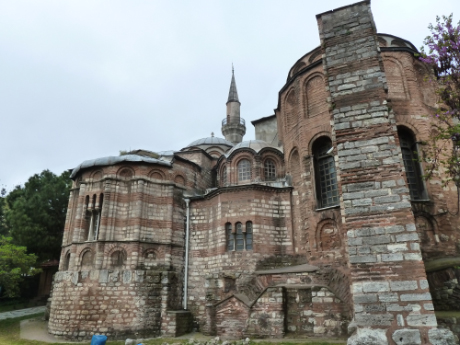 |
|
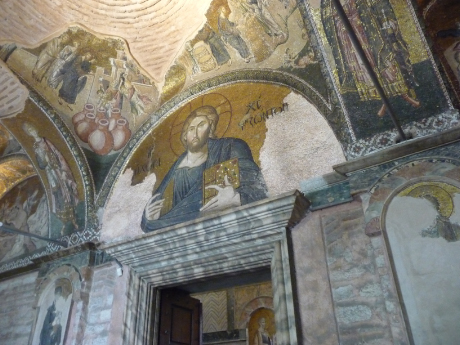 |
Our first stop was the Chora Church, a Greek Orthodox church. Built in the 11th century, it has an unusual architecture, as it uses flying buttresses to reinforce the walls.
|
|
The Chora Church is famous for its mosaics, most of which date from the early 1300s. As in many churches, Christ Enthroned is the theme of one major example. |
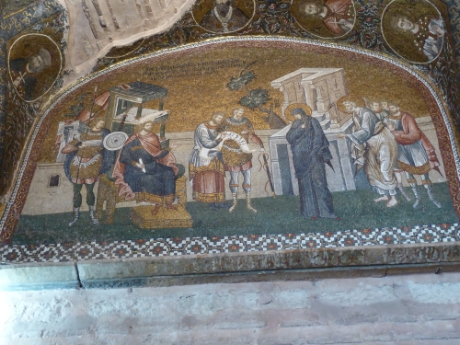 |
|
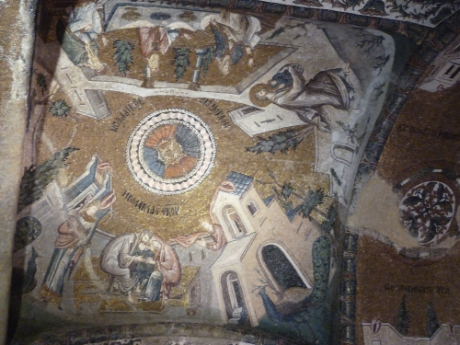 |
Some of the mosaics are very well-preserved, partly because they were plastered over while the church was a mosque. This one shows a less-common theme of Mary and Joseph registering for the Roman census.
|
|
The domed ceilings were a special challenge for the mosaic artists. This one shows scenes from the life of Mary and her parents, taken from the Apocryphal Gospel of James. |
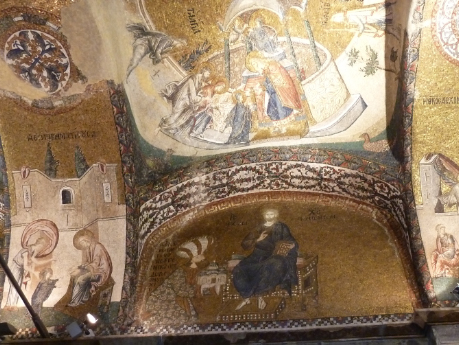 |
|
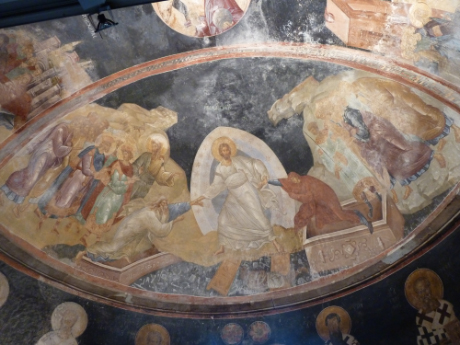 |
| Money counts: In the lower part of this mosaic, the donor, Theodore Metochites, is shown presenting a model of the church to Christ. |
|
The Chora Church also has some wonderful frescoes. This is one of Christ breaking the doors of Hell and bringing out Adam and Eve--a common theme in Byzantine art, but not in Western Christianity.
|
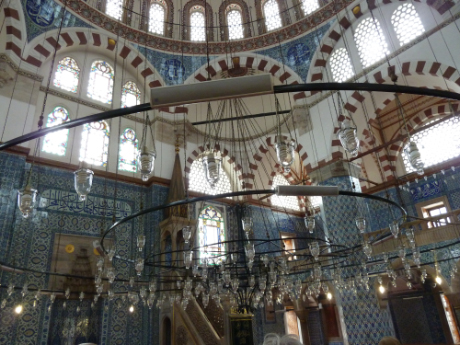 |
|
 |
| We also paid a brief visit to the Rustem Pasha mosque. It is famous for its use of Iznik (blue) tile and the tiles cover almost every surface. Unfortunately, it was almost time for prayers (it is a working mosque) so we had only a short time there. The complex used to include not only a mosque but a school, shelter, and food bank as well. |
|
One of the most famous mosques in Istanbul is the Sultan Ahmet (or Blue) Mosque. The Sultan directed his architect to make gold (altin) minarets but the architect misheard it as six (alti). SInce only Mecca had six minarets at the time, the Sultan sent his architect to add a seventh at Mecca.
|
 All of the walls and the domes are covered with tiles that are predominantly blue--hence the name that Europeans gave to the mosque. All of the walls and the domes are covered with tiles that are predominantly blue--hence the name that Europeans gave to the mosque.
|
|
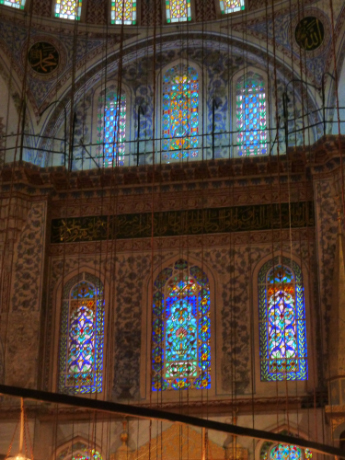 |
| |
|
In addition to the tile work, there are beautiful stained glass windows. Because of the Muslim rule of not portraying human figures, the windows use abstract designs.
|
 |
|
 |
These pictures give you an idea of how detailed and complex the tile work is, although it is much more stunning in person. The labor that must go into the creation and maintenance of these mosques is incredible.
|
 |
|
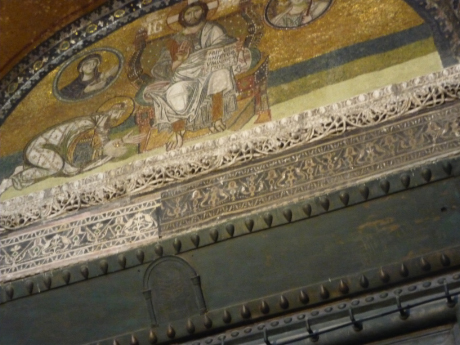 |
Hagia Sophia is the best-known of Istabul's landmarks. It is now a museum, but it used to be a church and then a mosque.
|
|
As with the Chora Church, many mosaics survived because they were plastered over during the mosque period. This one over the Imperial Door to the church depicts the Christ blessing the Byzantine Emperor Leo VI. It never hurts to have a friend in a high place.
|
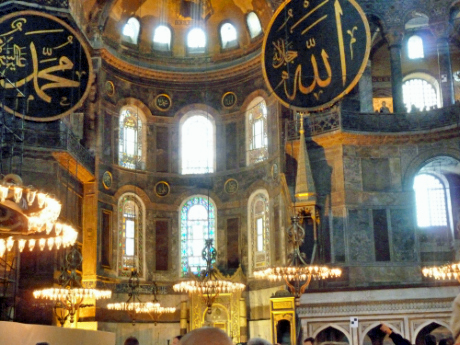 |
|
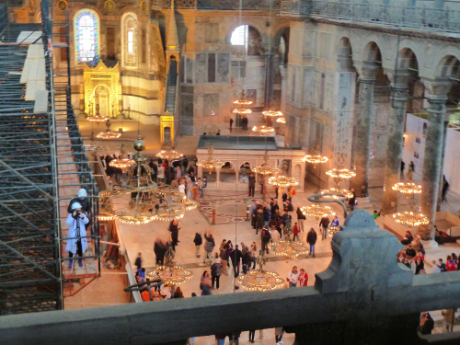 |
Because the building was at various times a Byzantine Church, a Catholic Church, and a mosque, it has a variety of decorations in it. When it became a museum the authorities wanted to remove these round shields (and two others) to establish a more secular tone, but the shields proved too large to take out the doors, so they are still there.
|
|
From the gallery you can see how large the building is, and this is just part of the first floor (part is closed off for renovation). |
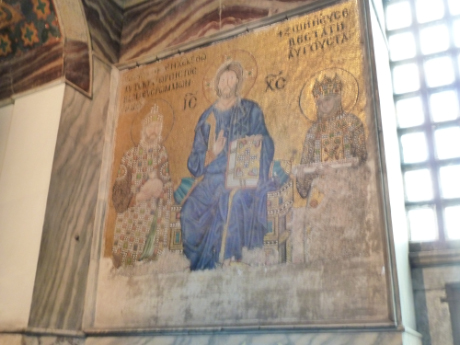 |
|
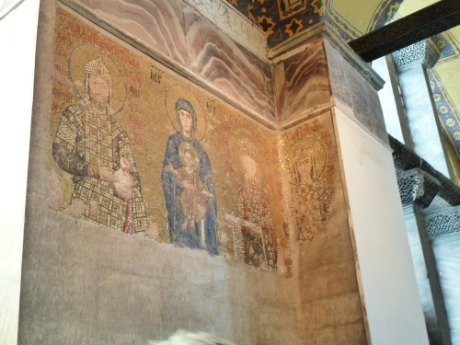 |
More political/religious mosaics: on the left is Christ with Emperor Constantine IX and Empress Zoe. On the right is Mary flanked by Emperor John II and the Empress Irene. On the corner is their son Alexius, whose skin has an unusual brownish tinge, possibly because he may have suffered from jaundice.
|








 All of the walls and the domes are covered with tiles that are predominantly blue--hence the name that Europeans gave to the mosque.
All of the walls and the domes are covered with tiles that are predominantly blue--hence the name that Europeans gave to the mosque.










